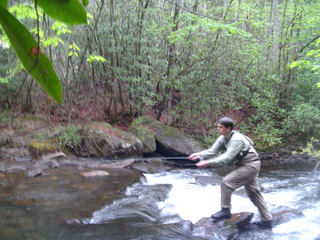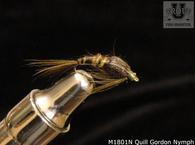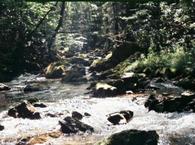If you want to consistently catch trout with a fly rod, you must learn to control how the fly and the fly line are affected by the various currents. The fly must move downstream as natural as possible. To ensure this in uneven currents you must mend the fly line. So what is mending the line? Mending the fly line is basically a technique to re-arrange your fly line on the surface of the water immediately after you've just completed a cast. The surface of almost all trout streams consists of several different currents. The water will be flowing at different speeds depending on where you are casting. There can be fast water in the runs, slower or mixed current speeds in the rifles, water will be slower along the banks or behind boulders, or different speeds at the bends in the stream. When you cast your fly line across the currents with different speeds, the various currents push on your line at different rates of speed, resulting in bellies forming in the fly line. There a couple of situations where a mend in the line is required.
Upstream Cast:
When you cast across a fast current and the fly lands in a slower current, the current will pull the fly faster downstream. Now the fly is moving faster than the water where it has landed so it is an unnatural drift and not a dead drift. Counteract that by moving the section of the fly line being pulled or pushed to a location upstream of the fly. To accomplish this, start with your rod tip low to the water, then quickly and heartily lift your rod tip high, flicking the line upstream.. In the process, you will quickly trace an imaginary circle with your rod tip. Ideally, the intersection of unmended and mended lines should be in the area where the two currents come together. As your fly drifts further downstream, you can continue to feed more line and make additional mends to increase the length of your drift. This is called an upstream mend.
Downstream Cast:
When you cast across slow current and your fly and part of your line and/or leader lands in fast current, you will need to make a downstream mend. This situation is just the opposite as mentioned above. The fast moving water where the fly has landed is moving faster than the line which has landed in the slow moving water. This causes the fly to drag because the fly line in the slow moving current is keeping the fly from drifting at the same speed of the fast current it's located in. It will also change the lane where you intend the fly to drift.
Now, a couple of tips for good mending: Always mend as soon as the fly touches down in the water. If there is too much slack in the line, a couple of quick strips will be necessary before the mend. Be sure to end up with your rod tip high well over your head.

You may have wondered what mending the fly line is. It can be a controversial subject, but one thing for sure, it is not repairing the fly line. In this course you will learn why it is necessary to mend as well as when to use a downstream cast and when to use an upstream cast. Can you mend while casting? That question will also be answered.
Finally remember, mending the fly line on the water does spook the trout under the line that is being picked up off the water as well as the trout underneath the area where the line lands. So if possible try to avoid the necessity of mending the line by making shorter casts.
Review the class 205 Fly Fishing Types of Casts.
Practice by fishing the different sections of the stream. Try to get familiar with as many different types of surface current conditions as you can possibly can. As you do practice this you should start to be able to read the water and predict what is going to happen during the drift. Then you can mend the line to get a great drag-free drift. This will improve your chances to catch that big elusive trout.





